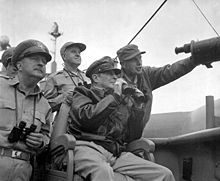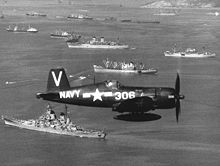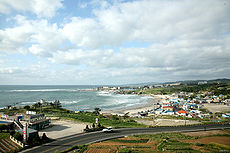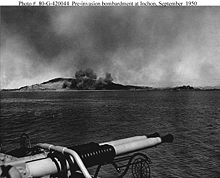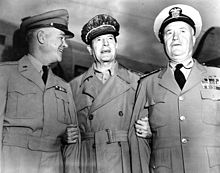- Battle of Inchon
-
Battle of Inchon Part of the Korean War 
Four tank landing ships unload men and equipment on Red Beach one day after the amphibious landings on Inchon.Date September 10–19, 1950 Location Incheon, South Korea, Yellow Sea Result Decisive United Nations victory Belligerents  United Nations
United Nations
 North Korea
North KoreaCommanders and leaders  Douglas MacArthur
Douglas MacArthur
 Arthur Dewey Struble
Arthur Dewey Struble
 Edward M. Almond
Edward M. Almond
 Oliver P. Smith[1]
Oliver P. Smith[1]
 Paik In-Yeop
Paik In-Yeop
 Shin Hyun-Joon
Shin Hyun-Joon Kim Il-sung
Kim Il-sung
 Choi Yong-Kun
Choi Yong-Kun
 Wol Ki Chan
Wol Ki Chan
 Wan Yong
Wan YongStrength 40,000 infantry
4 cruisers
7 destroyers
1 armed sampan
and an unknown number of naval and air forces6,500 infantry
19 aircraft [2]
1 fortress
1 patrol boat
and an unknown number of artilleryCasualties and losses Land:
222 killed
800 wounded
Sea:
2 killed
9 wounded
2 cruisers damaged
3 destroyers damaged
1 armed sampan damaged
Air:
1 aircraft destroyedLand:
1,350 killed
1 fortress damaged
Sea:
1 patrol boat sunk
Air:
1 aircraft destroyedNaval engagements of the Korean War (1950–53) and post-armistice incidentsPre Armistice
Korea Strait · Chumonchin Chan · Haeju · Inchon · Operation Wonsan · Operation Tailboard · Wonsan · Operation Fireball · Buzz Saw · Operation Kickoff · USS Walke Incident · Han RiverPost Armistice
Gangneung Incident (1996) · Yosu (1998) · Maritime border incidents (1999– ) · First Yeonpyeong (1999) · Second Yeonpyeong (2002) · Daecheong (2009) · Cheonan sinking (2010)North Korea offensive
UN intervention
- Air campaign
- Suwon Airfield
- Osan
- Pyongtaek
- Chonan
- Chochiwon
- Donglakri
- Danyang
- Jincheon
- Yihwaryeong
- Taejon
- Sangju
- Yeongdeok
- Yongdong
- Hwanggan
- Hwaryeongjang
- Younggang
- Andong
- Hadong
- The Notch
- Pusan Perimeter
- Haeju
- Inchon
- 2nd Seoul
- Hill 282
- Kaesong
- Operation Wonsan
- Wonsan
- Hungham
- Yongju
- Yeonghung
- Kumchon
- Pyongyang
- Huichon
- Chongju
- Chosan
Chinese intervention
- Onjong
- Unsan
- Pakchon
- Ch'ongch'on River
- Wawon
- Chosin Reservoir
- Task Force Faith
- 3rd Seoul
- 1st and 2nd Wonju
- Thunderbolt
- Twin Tunnels
- Roundup
- Hoengsong
- Chipyong-ni
- 3rd Wonju
- Killer
- 4th Seoul
- Courageous
- Tomahawk
- Rugged and Dauntless
- 5th Seoul (Imjin River
- Yultong
- Kapyong)
- Soyang River
Stalemate
- Bloody Ridge
- Han River
- Heartbreak Ridge
- Maryang San
- Sunchon
- Hill Eerie
- Sui-ho Dam
- Old Baldy
- Blaze
- Hudson Harbor
- White Horse
- Triangle Hill
- Jackson Heights
- The Hook
- Pork Chop Hill
- Outpost Harry
- Kumsong
- Samichon River
Post Armistice
- Korean DMZ Conflict (1966–1969)
- Blue House Raid
- Pueblo incident
- EC-121 shootdown
- Major Henderson incident
- Axe murder incident
- Rangoon bombing
- KAL Flight 858
- Gangneung
- Yosu
- 1st Yeonpyeong
- 2nd Yeonpyeong
- Daecheong
- Cheonan incident
- 3rd Yeonpyeong
The Battle of Inchon (Korean: 인천 상륙 작전, Hanja: 仁川上陸作戰, Incheon Sangnyuk Jakjeon; code name: Operation Chromite) was an amphibious invasion and battle of the Korean War that resulted in a decisive victory and strategic reversal in favor of the United Nations (UN). The operation involved some 75,000 troops and 261 naval vessels, and led to the recapture of the South Korean capital Seoul two weeks later.[3]
The battle began on September 15, 1950, and ended September 19. Through a surprise amphibious assault far from the Pusan Perimeter that UN and South Korean forces were desperately defending, the largely undefended city of Incheon was secured after being bombed by UN forces. The battle ended a string of victories by the invading North Korean People's Army (NKPA). The subsequent UN recapture of Seoul partially severed NKPA's supply lines in South Korea.
The majority of United Nations ground forces involved were U.S. Marines, commanded by General of the Army Douglas MacArthur. MacArthur was the driving force behind the operation, overcoming the strong misgivings of more cautious generals to a risky assault over extremely unfavorable terrain.
Contents
Background
Planning
The idea to land UN forces at Incheon was suggested by MacArthur after he visited the Korean battlefield on June 29, 1950, four days after the war began. MacArthur thought that the North Korean army would push the South Korean army back far past Seoul.[4] He decided that the battered, demoralized, and under-equipped South Koreans, many of whom did not support the SK government put in power by the US, could not hold off the NKPA, who also defeated the American reinforcements. MacArthur felt that he could turn the tide if he made a decisive troop movement behind enemy lines.[5] He hoped that a landing near Incheon would allow him to cut off the NKPA and destroy that army as a useful fighting force, thus winning the war.[6]
In order to accomplish such a large amphibious operation, MacArthur requested the use of United States Marine Corps expeditionary forces, having become familiar with their ability to integrate amphibious operations in the Pacific during World War II. However, the Marines at that point were still recovering from a series of severe program cutbacks instituted by the Truman administration and Secretary of Defense Louis A. Johnson. Indeed, Johnson had tried to eliminate the Marines entirely and slashed Marine expeditionary forces from a World War II peak of 300,000 men to just over 27,000.[citation needed] Much of the Marines' landing craft and amphibious carriers had been sold off, scrapped, or transferred to the exclusive use of the U.S. Army.
After hastily re-equipping Marine forces with aging World War II landing craft, withdrawing Marine units from the Pusan perimeter, and stripping recruitment depots bare of men, Marine commanders were just able to mount a force capable of undertaking offensive operations against the small North Korean forces.[7][8]
MacArthur decided to use the Joint Strategic and Operations Group (JSPOG) of his Far East Command (FECOM). The initial plan was met with skepticism by the other generals because Incheon's natural and artificial defenses were formidable.[9] The approaches to Incheon were two restricted passages, Flying Fish and Eastern channels, which could be easily blocked by mines.
The current of the channels was also dangerously quick—three to eight knots. Finally, the anchorage was small and the harbor was surrounded by tall seawalls. Commander Arlie G. Capps noted "We drew up a list of every natural and geographic handicap—and Incheon had 'em all."[10] MacArthur cancelled an initial plan, Operations Bluehearts, which called for an attack on Incheon on July 22, because of the difficulties of a complicated amphibious assault and a lack of sufficient training for troops.[11]
An important briefing on Incheon took place on August 23 at MacArthur's headquarters in Tokyo. Army Chief of Staff Joseph Lawton (Joe) Collins, Chief of Naval Operations Forrest Sherman, and Lieutenant General Idwal H. Edward, the Air Force operations deputy, all flew from Washington to Japan to take part in the briefing; Air Force Chief of Staff Hoyt Vandenberg did not attend, possibly because he "did not want to legitimize an operation that essentially belong to the Navy and the Marines." The Marine Corps staff, who were to be responsible for leading the landing at Incheon, were not invited, which became a contentious issue. During the briefing nine members of the staff of Admiral James Henry Doyle spoke for nearly 90 minutes on every technical and military aspect of the landing; after his staff spoke, Doyle stood up and said, "General, I have not been asked, and I have not volunteered my opinion about this landing. If I were asked, however, the best I can say is that Inchon is not impossible," and then sat down.[12]
Collins suggested that alternatives sites to the south of Incheon such as Gunsan or Posung-Myon some 20 miles south of Incheon be considered instead, a suggestion that MacArthur had expected. MacArthur, however, was determined to win approval for an assault on Incheon, and he aimed to convince Sherman of the necessity of an Incheon landing. Drawing an analogy to the Battle of the Plains of Abraham at Quebec in 1759, in which British troops under James Wolfe had caught French troops under the Marquis de Montcalm by surprise, MacArthur argued that the difficulties presented by an Incheon landing could be surpassed, and that the North Koreans would be caught unprepared, reasoning that "no one would be so brash to make such an attempt."[13]
MacArthur told the officers that though a Gunsan landing would bring a relatively easy linkup with the Eighth Army, a landing there "would be an attempted envelopment that would not envelop" and would place more troops in a vulnerable pocket of the Pusan Perimeter. McArthur won over Sherman by speaking of his affection for the Navy and relating the story of how the Navy carried him out of Corregidor to safety during the Pacific War. Sherman agreed to support the Incheon operation, leaving Doyle furious.[14]
Despite these obstacles, in September MacArthur issued a revised plan of assault on Incheon: Plan 100-B, codenamed Operation Chromite. MacArthur spent 45 minutes after the briefing explaining his reasons for choosing Incheon.[15]
He said that because it was so heavily defended, the enemy would not expect an attack there, that victory at Incheon would avoid a brutal winter campaign, and that, by invading a northern strong point, the UN forces could cut off North Korean lines of supply and communication.[16] Incheon was also chosen because of its proximity to Seoul. Admiral Forrest P. Sherman and General J. Lawton Collins returned to Washington, D.C., and had the invasion approved.
The landing at Incheon was not the first large-scale amphibious operation since World War II. That distinction belonged to the July 18, 1950, landing at Pohang. However, that operation was not made in enemy-held territory and was unopposed.[17]
Prelude
Before the main land battle, U.N. forces landed spies in Incheon and bombarded the city's defenses via air and sea.
Incheon Infiltration
Fourteen days before the main attack on Incheon, a joint Central Intelligence Agency–military intelligence reconnaissance effort, codenamed Trudy Jackson, placed a team in Incheon. The group, led by Navy Lieutenant Eugene F. Clark, landed at Yonghung-do, an island in the mouth of the harbor. From there, they relayed intelligence back to U.S. forces.
With the help of locals, Lt. Clark, Korean Navy Lt. Youn Joung and former Korean counterintelligence officer Colonel Ke In-Ju gathered information about tides, beach composition, mudflats and seawalls.[18] They reported detailed North Korean artillery positions and enemy fortifications at Wolmi-do, Inchon and nearby islands. Critical to future success of the invasion, Clark reported that the channels were not mined.[19]
When the North Koreans discovered that the agents had entered the islands near Inchon, they made multiple attacks, including an attempted raid on Yonghung-do with 6 junks. Clark mounted a machine gun on a sampan and sank the attack boats.[20] In response, the North Koreans killed up to 50 civilians for helping Clark.[21]
The mission's most important position taken was the lighthouse on Palmi-do, which was restarted hours before the invasion fleet arrived.[9]
The mission is detailed in its entirety in the first-hand account by Commander Eugene F. Clark in The Secrets of Inchon: The Untold Story of the Most Daring Covert Mission of the Korean War.[22]
Bombardments of Wolmi-do Fortress and Inchon
A series of drills and tests and raids were conducted elsewhere on the coast of Korea, where conditions were similar to Inchon, before the actual invasion. These drills were used to perfect the timing and performance of the landing craft[17] and to confuse the North Koreans on the location of the invasion.
On September 10, 1950, five days before the Inchon landing, 43 American warplanes flew over Wolmi-do island, dropping 93 napalm canisters to “burn out” its eastern slope in an attempt to clear the way for American troops.[23]
As the landing groups neared, cruisers and destroyers from the United States and Canada shelled the fortified Wolmi-do Island and checked for mines in Flying Fish Channel. The first Canadian forces entered the Korean War when HMCS Cayuga, HMCS Athabaskan and HMCS Sioux bombarded the coast. The Fast Carrier Force flew fighter cover, interdiction, and ground attack missions. Hundreds of Korean civilians were killed in these attacks on the lightly defended port.
At 07:00 on September 13, Destroyer Squadron Nine, headed by the USS Mansfield, sailed up Eastern Channel and into Inchon Harbor, where it fired upon enemy gun emplacements at Wolmi-do. The attacks tipped off the North Koreans that a landing might be imminent. The North Korean officer at Wolmi-do assured his superiors that he would throw the enemy back into the sea.[24]
Throughout the naval bombardment, one U.S. sailor was killed and six U.S. others were wounded. The one dead, David H. Swenson from USS Lyman K. Swenson, was later reported by the world media as being the nephew of Captain Lyman Knute Swenson, USS Swenson's namesake, but this was later found to be false. Significant damage was inflicted on three of the attacking warships.
USS Collett received the most damage; she took nine 75-millimeter shells hit, which wounded five men. USS Gurke sustained three shells hit resulting in light damage and no casualties. Over a thousand 5-inch shells were fired by the Canadian-American destroyer force, after inflicting severe damage on Wolmi-do's fortifications for an hour. Canadian casualties are unknown, if any.
The destroyers withdrew and allied cruisers proceeded to bombard the North Korean batteries for the next three hours from the south of the island. Lt. Clark and his Korean squad watched from hills south of Inchon, plotting locations where machine guns were firing at the U.S. ships. This information was relayed to the invasion force via Japan in the afternoon.[25]
That night, Admiral Struble decided on another day of bombardment, and the destroyers moved back up the channel off Wolmi-do.
On September 14 the destroyers and cruisers bombarded the island again and planes from the carrier task force bombed and strafed.
On the morning of September 15, the attack group of ships followed the destroyers, entered Flying Fish Channel, and the Marines got ready to make the landings on Wolmi-do.[26]
Battle
The flotilla of ships that landed during the battle was commanded by VADM Arthur Dewey Struble, an expert in amphibious warfare. Struble had participated in amphibious operations in World War II, including the Battle of Leyte and the Battle of Normandy.[27] Vice Admiral Struble's flagship, the cruiser USS Rochester, sailed on September 12, 1950 to Inchon.
At 12:50 am on September 15, 1950, the lighthouse at Palmi-do was activated by Lt. Eugene Clark and his Korean squad.[28]
Green Beach
At 06:30 on September 15, 1950, the lead elements of X Corps hit "Green Beach" on the northern side of Wolmi-do island. The landing force consisted of the 3rd Battalion 5th Marines and nine M26 Pershing tanks from the 1st Tank Battalion.[citation needed] One tank was equipped with a flamethrower (flame tank) and two others had bulldozer blades. The battle group landed in LSTs designed and built during World War II. The entire island was captured by noon at the cost of just 14 casualties.[29]
The North Korean forces were outnumbered by more than six to one by the U.N. troops. North Korean casualties included over 200 killed and 136 captured, primarily from the 918th Artillery Regiment and the 226th Independent Marine Regiment.[30] The forces on Green Beach had to wait until 19:50 for the tide to rise, allowing another group to land. During this time, extensive shelling and bombing, along with anti-tank mines placed on the only bridge, kept the small North Korean force from launching a significant counterattack.[citation needed] The second wave came ashore at "Red Beach" and "Blue Beach."
The North Korean army had not been expecting an invasion at Incheon.[31] After the storming of Green Beach, the NKPA assumed (probably because of deliberate American disinformation) that the main invasion would happen at Gunsan.[citation needed] As a result, only a small force was diverted to Incheon. Even those forces were too late, and they arrived after the UN forces had taken Blue Beach and Red Beach. The troops already stationed at Incheon had been weakened by Clark's guerrillas, and napalm bombing runs had destroyed key ammunition dumps. In total, 261 ships took part.[citation needed]
For Red Beach and Blue Beach, Vice Admiral James H. Doyle, Commander of an Amphibious ready group, announced that H-Hour, time of landing, would be 17:30.
Red Beach
General of the Army Douglas MacArthur (center) grasps General J. Lawton Collins (the Army Chief of Staff, left) and Admiral Forrest Sherman (the Chief of Naval Operations right). MacArthur used their meeting to convince other military leaders that the assault on Incheon was necessary.
The Red Beach forces, made up of the Regimental Combat Team 5, which included the 3rd Battalion of the Republic of Korea Marine Corps (ROKMC), used ladders to scale the sea walls. Major General Raymond L. Murray's, served as Commanding Officer of the 5th Marines, mission was to seize an area three thousand yards long and a thousand yards deep, extending from Cemetery Hill (northern) at the top down to the Inner Tidal Basin(near Tidal Basin at the bottom) and including the promontory in the middle called Observatory Hill. (See Map) The 1st Battalion would be on the left, against Cemetery Hill and northern half of Observatory Hill. The 2nd Battalion would take the southern half of Observatory Hill and Inner Basin.[32]
Late that afternoon of September 15, the LSTs closed Red Beach and as the lead ships they came under heavy mortar and machine gun fire from North Korean defenders on Cemetery Hill. Despite the concentrated fire, they debarked assault troops and unloaded vital support equipment. In addition their guns wiped out enemy batteries on the right flank of Red Beach. Three (LST 857, LST 859 and LST 973 ) of the eight LSTs took some hits from mortar and machine gun fire, which killed a sailor and injured a few others.[33] The LSTs completed unloading and cleared the beach at high tide early on 16 September.
After neutralizing North Korean defenses at Inchon on the night of September 15, they opened the causeway to Wolmi-do, allowing the 3rd Battalion of the 5th Marines and the tanks from Green Beach to enter the battle at Inchon. Early morning on September 16, the 5th Marines (Red and Green Beaches forces) would march through the city in Inchon, taking it by the afternoon.
Red Beach forces suffered eight dead and 28 wounded.[citation needed]
Blue Beach
Under the command of then-Colonel Lewis Burwell "Chesty" Puller, the 1st Marine Regiment landing at Blue Beach was significantly south of the other two beaches and reached shore last. The mission of Colonel Puller's 1st Marines in this landing was to take the beachhead, and the road to Yongdungpo and Seoul. The 2nd Battalion would land on the left at Blue Beach One (see Map) and 3rd Battalion would land on Blue Beach Two. A little cove around the corner south of Blue Beach Two was called Blue Beach Three.[34] As they approached the coast, the combined fire from several NKPA gun emplacements sank one LST. Destroyer fire and bombing runs silenced the North Korean defenses. When they finally arrived, the North Korean forces at Incheon had already surrendered, so the Blue Beach forces suffered few casualties and met little opposition. The 1st Marine Regiment spent much of its time strengthening the beachhead and preparing for the inland invasion.
Attack on USS Rochester
Just before daylight at 0550 on September 17, a North Korean Yak-9 and an II-2 made an attack run on the cruiser USS Rochester, anchored off Wolmi-do. Initially the aircraft were thought to be friendly until they dropped four bombs over the American ship. All but one missed and the one that did hit dented the Rochester's crane and failed to detonate. There were no American casualties in the skirmish and they painted a Purple Heart on the crane as a reminder of how close the ship came to being heavily damaged. After the bombing of the Rochester, she and the nearby cruiser HMS Jamaica opened fire with naval guns. The North Korean II-2 then strafed the British cruiser, resulting in one sailor killed and two wounded. At about the same time, shots from the Jamaica hit the II-2 and it crashed into the water. It became the first and only shootdown of an attacking plane with naval gunfire. The Yak-9 fled after losing its partner.[35][36][37]
Aftermath
Beachhead
 Lieutenant Baldomero Lopez of the Marine Corps is shown scaling a seawall after landing on Red Beach (September 15). Minutes after this photo was taken, Lopez was killed after covering a live grenade with his body.[38] He was posthumously awarded the Medal of Honor.
Lieutenant Baldomero Lopez of the Marine Corps is shown scaling a seawall after landing on Red Beach (September 15). Minutes after this photo was taken, Lopez was killed after covering a live grenade with his body.[38] He was posthumously awarded the Medal of Honor.
Immediately after North Korean resistance was extinguished in Incheon, the supply and reinforcement process began. Seabees and Underwater Demolition Teams (UDTs) that had arrived with the U.S. Marines constructed a pontoon dock on Green Beach and cleared debris from the water. The dock was then used to unload the remainder of the LSTs.
Documents written by Kim Il-sung and recovered by UN troops soon after the landing said, "The original plan was to end the war in a month, we could not stamp out four American divisions... We were taken by surprise when United Nations troops and the American Air Force and Navy moved in."[citation needed]
Early that morning of September 16, Colonel Murray and Colonel Puller had their operational orders from General Oliver P. Smith. The 1st Marines and 5th Marines began moving along the Inchon-Seoul road.
On September 16, the North Koreans, realizing their blunder, sent six columns of T-34 tanks to the beachhead. They were quite alone, without infantry support. They were spotted by a strike force of F4U Corsair at the village of Kansong-ni, east of Inchon.[39] In response, two flights of F4U Corsair from marine squadron VMF-214 bombed the attackers. The armored columns suffered extensive damage and the US forces lost one airplane. A quick counter-attack by M26 Pershing tanks destroyed the remainder of the North Korean armored division and cleared the way for the capture of Incheon.
Capture of Kimpo airfield
The Kimpo airfield was the largest and most important in Korea.[40]
On September 17, General MacArthur was extremely urgent in his request for early capture of Kimpo airfield for it was the largest air base in all of Korea. Once it was secured, the Fifth Air Force could bring fighters and bombers up from Japan to operate more easily against North Korea.[41] The attack on Kimpo airfield was carried out by 2nd Battalion 5th Marines.[42] That night at Kimpo, the North Koreans were organizing their defense of the airfield. Kimpo was under the command of Brigadier General Wan Yong.[42] General Wan's troops were a conglomeration of half-trained fighting men and service forces. Several North Korean troops had already fled across the Han River toward Seoul to escape the fight. The North Korean's defense was almost as bad as the morale of the men who realized that they were not going to get any help from the North Korean officials in Seoul.[43]
By morning the enemy were all gone, and Kimpo airfield was securely in the hands of the marines. Kimpo airfield was in excellent shape; the enemy had not had time to do any major demolition. In fact, several enemy planes were still on the field. So Kimpo now could become the center of Allied land-based air operations.[44]
On September 19, the U.S. Army Corps of Engineers repaired the local railroad up to eight miles (13 km) inland. After captured of Kimpo airfield, transport planes began flying in gasoline and ordnance for the aircraft stationed there. The Marines continued unloading supplies and reinforcements. By September 22, they had unloaded 6,629 vehicles and 53,882 troops, along with 25,512 tons (23,000 tonnes) of supplies.[citation needed]
Battle of Seoul
Main article: Second Battle of Seoul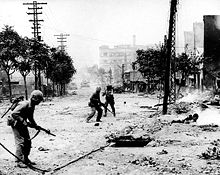 U.S. Marines engaged in urban warfare during the battle for Seoul in late September 1950. The Marines are armed with an M1 rifle and an M1918 Browning Automatic Rifle. On the street are Korean civilians who died in the battle. In the distance are M4 Sherman tanks.
U.S. Marines engaged in urban warfare during the battle for Seoul in late September 1950. The Marines are armed with an M1 rifle and an M1918 Browning Automatic Rifle. On the street are Korean civilians who died in the battle. In the distance are M4 Sherman tanks.
In contrast to the quick victory at Incheon, the advance on Seoul was slow and bloody. The NKPA launched another T-34 attack, which was trapped and destroyed, and a Yak bombing run in Incheon harbor, which did little damage. The NKPA attempted to stall the UN offensive to allow time to reinforce Seoul and withdraw troops from the south.[citation needed] Though warned that the process of taking Seoul would allow remaining NKPA forces in the south to escape, MacArthur felt that he was bound to honor promises given to the South Korean government to retake the capital as soon as possible.[citation needed]
On the second day, vessels carrying the U.S. Army's 7th Infantry Division arrived in Incheon Harbor. General Almond was eager to get the division into position to block a possible enemy movement from the south of Seoul. On the morning of September 18, the division's 2nd Battalion of the 32nd Infantry Regiment landed at Incheon and the remainder of the regiment went ashore later in the day. The next morning, the 2nd Battalion moved up to relieve an U.S. Marine battalion occupying positions on the right flank south of Seoul. Meanwhile, the 7th Division's 31st Regiment came ashore at Incheon. Responsibility for the zone south of Seoul highway passed to 7th Division at 18:00 on September 19. The 7th Infantry Division then engaged in heavy fighting with North Korean soldiers on the outskirts of Seoul.
Before the battle, North Korea had just one understrength division in the city, with the majority of its forces south of the capital.[45] MacArthur personally oversaw the 1st Marine Regiment as it fought through North Korean positions on the road to Seoul. Control of Operation Chromite was then given to Major General Edward Almond, the X Corps commander. General Almond was in an enormous hurry to capture Seoul by September 25, exactly three months of the North Korean assault across the 38th parallel.[46] On September 22, the Marines entered Seoul to find it fortified. Casualties mounted as the forces engaged in house-to-house fighting. On September 26, the Hotel Bando (which had served as the US Embassy) was cleared by Easy Company of 2nd Battalion, 1st Marine Regiment. During this fight about 12 North Korean P.O.W.s were killed (apparently while naked and unarmed) in the building's basement.[47]
General Almond declared the city liberated on September 25 even though Marines were still engaged in house-to-house combat.
Pusan Perimeter breakout
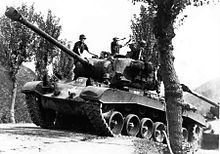 The M26 Pershing enjoyed domination over T-34 tanks at Inchon. One tank (B41) of B Company, 1st Tank Battalion, U.S Marines, landed on Pusan port on August 2, 1950, destroying a large number of tanks of the North Korean 42nd Armored Regiment.[48]
The M26 Pershing enjoyed domination over T-34 tanks at Inchon. One tank (B41) of B Company, 1st Tank Battalion, U.S Marines, landed on Pusan port on August 2, 1950, destroying a large number of tanks of the North Korean 42nd Armored Regiment.[48]
Meanwhile, 5th Marines came ashore at Inchon. The last North Korean troops in South Korea still fighting were defeated when Walton H. Walker's 8th Army broke out of the Pusan Perimeter, joining the Army's X Corps in a coordinated attack on NKPA forces. Of the 70,000 NKPA troops around Pusan, in the aftermath of the Pusan Perimeter battle, North Korean casualties from September 1 to September 15 could range from roughly 41,000 to 36,000 killed and captured, with an unknown total number of wounded.[49] However, because UN forces had concentrated on taking Seoul rather than cutting off the NKPA's withdrawal north, the remaining 30,000 North Korean soldiers escaped to the north across the Yalu River, where they were soon reconstituted as a cadre for the formation of new NKPA divisions hastily re-equipped by the Soviet Union. The allied assault continued north to the Yalu River until the intervention of the People's Republic of China in the war.
Analysis
Most military scholars consider the battle one of the most decisive military operations in modern warfare. However, Russell Stolfi argues that the landing itself was a strategical masterpiece but it was followed by an advance to Seoul in ground battle so slow and measured that it constituted an operational disaster, largely negating the successful landing. He contrasts the US style of war fighting with that of Germany by examining the US military's 1950 Incheon-Seoul operation and the German offensive in the Baltic in 1941. American forces achieved a strategic masterpiece in the Incheon landing in September 1950 and then largely negated it by a slow, tentative, 11-day advance on Seoul, only twenty miles away. By contrast in the Baltic region in 1941 the German forces achieved strategic surprise in the first day of their offensive and then, exhibiting a breakthrough mentality, pushed forward rapidly, seizing key positions and advancing almost two hundred miles in four days. The American advance was characterized by cautious, restrictive orders, concerns about phase lines, limited reconnaissance, and command posts well in the rear, while the Germans positioned their leaders as far forward as possible, relied on oral or short written orders, reorganized combat groups to meet immediate circumstances, and engaged in vigorous reconnaissance.[50]
Popular culture
The Battle of Incheon was the subject of the 1982 film Inchon, which did poorly at the box office amid controversy over its being partially financed by the leader of the Unification Church Sun Myung Moon. Previously, the Battle of Incheon was featured in Joseph H. Lewis's 1952 film for Milton Sperling and Warner Brothers Retreat, Hell!.
The concert band work "Incheon" by Robert W. Smith is about the battle. It begins with a flute solo, and slowly brings in percussion sound effects, such as machine gun and artillery fire and helicopter noise. It also has references to Variations on a Korean Folk Song (measures 61, 62, 65, and 66).
The W. E. B. Griffin novel Under Fire is a fictionalized account of the political and personal maneuvering that occurred during MacArthur's development of the Incheon invasion plan.
Notes
- ^ Halberstam 2007, p. 302
- ^ Hoyt 1984, p. 11. They did not anticipate any air opposition for, as far as intelligence knew, the North Koreans had only nineteen planes left.
- ^ The Independent, 16 September 2010, p.35 reporting on a 60th anniversary re-enactment
- ^ MacArthur, Douglas, Reminiscences [1964], McGraw-Hill, New York, p. 333.
- ^ MacArthur, Douglas, Reminiscences [1964], McGraw-Hill, New York, p. 350.
- ^ Clark 2002, pp. 9
- ^ Blair, Clay The Forgotten War: America in Korea, 1950–1953, Naval Institute Press (2003)
- ^ Krulak, Victor H. (Lt. Gen.), First to Fight: An Inside View of the U.S. Marine Corps, Naval Institute Press (1999)
- ^ a b Linda Petty. "Incheon invasion a turning point in Korean War". cnn.com. Archived from the original on 2008-03-21. http://web.archive.org/web/20080321065931/http://archives.cnn.com/2000/US/09/14/inchon.invasion/index.html. Retrieved 2008-09-16.
- ^ Edward J. Marolda, The U.S. Navy in the Korean War (2007), Naval Institute Press: Annapolis, Maryland, p. 68.
- ^ Halberstam 2007, pp. 294–295.
- ^ Halberstam 2007, pp. 298–299
- ^ Halberstam 2007, p. 299
- ^ Halberstam 2007, p. 300
- ^ Utz 1994, p. 18
- ^ MacArthur, Douglas, Reminiscences [1964], McGraw-Hill, New York, p. 349-350.
- ^ a b "Landings By Sea Not New In Korea", The New York Times: 3, September 15, 1950, http://select.nytimes.com/gst/abstract.html?res=F70B15FA395A1A7B93C7A81782D85F448585F9
- ^ Clark 2002, pp. 15, 357
- ^ Shaw, Ronald, Reinventing Amphibious Hydrography: The Inchon Assault and Hydrographic Support for Amphibious Operations, 2008, Naval War College, Newport, RI, p. 4-5
- ^ Clark 2002, pp. 216–222
- ^ Fleming, Thomas, epilogue to The Secrets of Inchon, 2002, p. 323
- ^ Commander Eugene Franklin Clark, "The Secrets of Inchon: The Untold Story of the Most Daring Covert Mission of the Korean War", 2002
- ^ Choe, Sang-Hun (August 3, 2008), "South Korea Says U.S. Killed Hundreds of Civilians", New York Times, http://www.nytimes.com/2008/08/03/world/asia/03korea.html
- ^ Utz 1994, p. 25
- ^ Clark 2002, pp. 294.
- ^ Hoyt 1984, p. 13
- ^ Parrott, Lindesay (September 18, 1950), "United States Marines Headed For Seoul", The New York Times: 1, http://select.nytimes.com/gst/abstract.html?res=F50E11F8395A1A7B93CAA81782D85F448585F9
- ^ Clark 2002, pp. 419, 430
- ^ Alexander, Joseph H.; Horan, Don (1999), The Battle History of the U.S. Marines: A Fellowship of Valor, New York: HarperCollins, p. v, ISBN 0060931094
- ^ Gammons, Stephen L.Y.. The Korean War: The UN Offensive. United States Army Center of Military History. CMH Pub 19-7. http://www.history.army.mil/brochures/kw-unoff/unoff.htm.
- ^ Clark 2002, pp. 206, 280
- ^ Hoyt 1984, p. 20
- ^ Hoyt 1984, p.31
- ^ Hoyt 1984, p.28
- ^ Account of Jamaica in the Korean War
- ^ http://www.history.navy.mil/wars/korea/chron50.htm#jun
- ^ http://www.ussrochester.org/gray_ghost/grayghost.pdf
- ^ "The Incheon Invasion, September 1950: Overview and Selected Images" from Naval Historical Center and " First Lieutenant Baldomero Lopez, USMC" from US Marine Corps
- ^ Hoyt 1984, p. 34
- ^ Hoyt 1984, p. 36
- ^ Hoyt 1984, p. 56
- ^ a b Hoyt 1984, p. 58
- ^ Hoyt 1984, pp. 58–59
- ^ Hoyt 1984, p. 61
- ^ Baldwin, Hanson W. (September 27, 1950), "Invasion Gamble Pays", The New York Times: 6, http://select.nytimes.com/gst/abstract.html?res=F70716FE3A5F11738DDDAE0A94D1405B8089F1D3, retrieved June 18, 2006
- ^ Hoyt 1984, p. 77
- ^ Longabardi, Eric; Roane, Kit; Pound, Edward (November 3, 2003), "A War of Memories", U.S. News & World Report: p. 33, http://www.usnews.com/usnews/news/articles/031103/3korea_2.htm, "Garabedian describes a hellish, dangerous moment. Marines rushed through the building, going from room to room, bursting in on the North Korean forces shooting from the windows. Several marines were wounded, he says, as the squads ran through the hallways, killing some of the North Koreans. Garabedian recalls being on the second floor of the building. He set up by a window and had a view up and down the building's staircase. As some marines continued to clear out the building, others took prisoners down the stairwell to another marine in a bath area. There were about 12 prisoners. The marine in charge was guarding them with his Browning automatic rifle. All were forced to strip to make sure none still had weapons."
- ^ 1/35 M26 Pershing, Tamiya
- ^ Appleman, Roy E. (1998). South to the Naktong, North to the Yalu: United States Army in the Korean War. New York: Department of the Army. p. 604.
- ^ Stolfi, Russel H. S. (2004), "A Critique of Pure Success: Incheon Revisited, Revised, and Contrasted", Journal of Military History 68 (2): 505–525, ISSN 0899-3718, http://muse.jhu.edu/journals/journal_of_military_history/v068/68.2stolfi.html
References
- The Incheon Invasion, September 1950—Overview and Selected Images. U.S. Department of the Navy/Naval Historical Center.
- The Landing at Inchon. Canadians in Korea: Valour Remembered. Veterans Affairs Canada.
- Assault from the Sea: The Amphibious Landing at Incheon. U.S. Department of the Navy/Naval Historical Center.
- Ballard, John R, "Operation Chromite: Counterattack at Inchon", Joint Forces Quarterly (Spring/Summer 2001), http://www.dtic.mil/doctrine/jel/jfq_pubs/0928.pdf
- Blair, Clay (2003), The Forgotten War: America in Korea, 1950–1953, Naval Institute Press, ISBN 9781591140757
- Bradford, Jeffrey A, "MacArthur, Inchon and the Art of Battle Command", Military Review (2001 81(2)): pp. 83–86, ISSN 0026-4148 MacArthur's understanding and use of battle command were critical for the operation's success. Battle command requires decisionmaking, leadership, and motivation of soldiers and organizations
- Clark, Eugene Franklin (2002), The Secrets of Inchon: The Untold Story of the Most Daring Covert Mission of the Korean War, Putnam Pub Group, ISBN 0-399-14871-X
- Halberstam, David (2007), The Coldest Winter – America and the Korean War, New York: Hyperion, ISBN 978-140130-052-4
- Heefner, Wilson A, "The Inch'on Landing", Military Review (1995 75(2)): pp. 65–77, ISSN 0026-4148
- Heinl, Robert D. Jr, "The Inchon Landing: A Case Study in Ampibious Planning", Naval War College Review (Spring 1998, Vol. LI, No. 2), http://www.nwc.navy.mil/press/Review/1998/spring/art7-sp8.htm
- Heinl, Robert Debs (1979), Victory at High Tide: The Inchon-Seoul Campaign, Baltimore, Maryland: The nautical and Aviation Publishing Company of America, ISBN 9780933852037
- Hoyt, Edwin P. (1984), On to the Yalu, New York: Stein and Day, ISBN 0812829778
- Krulak, Victor H. (Lt. Gen.) (1999), First to Fight: An Inside View of the U.S. Marine Corps, Naval Institute Press, ISBN 9781557504647
- Montross, Lynn (1954), U.S. Marine Operations in Korea, 1950–1953, V.1. The Pusan Perimeter, Washington: Historical Branch, G-3, Headquarters, Marine Corps, OCLC 12408939
- Montross, Lynn, "The Inchon Landing—Victory over Time and Tide", The Marine Corps Gazette (July 1951), http://www.koreanwar-educator.org/topics/branch_accounts/marine/p_inchon_landing.htm
- Rottman, Gordon R (2006), Inch'on 1950; The last great amphibious assault, Osprey Campaign Series, Osprey Publishing, ISBN 1841769614
- Schnabel, James F (1972), United States Army in the Korean War: Policy and Direction: The First Year, Washington, D.C.: Office of the Chief of Military History, http://www.history.army.mil/books/p&d.htm CMH Pub 20-1-1. Full text online, ch 8–9.
- Simmons, Edwin H (2000), Over the Seawall: US Marines at Incheon, Part 1, Marines in the Korean War Commemorative Series, US Marine Corps History Center, http://www.marines.mil/news/publications/Pages/OVER%20THE%20SEAWALL%20PT%201.aspx
- Simmons, Edwin H (2000), Over the Seawall: US Marines at Incheon, Part 2, Marines in the Korean War Commemorative Series, US Marine Corps History Center, http://www.marines.mil/news/publications/Pages/OVER%20THE%20SEAWALL%20PT%202.aspx
- Stolfi, Russel H. S, "A Critique of Pure Success: Inchon Revisited, Revised, and Contrasted", Journal of Military History (2004 68(2)): pp. 505–525, doi:10.1353/jmh.2004.0075 Contrasts the US style of war fighting with that of Germany by examining the US military's 1950 Inchon-Seoul operation and the German offensive in the Baltic in 1941.
- Utz, Curtis (1994), Assault from the Sea: The Amphibious Landing at Inchon, Washington DC: Naval Historical Center, ISBN 9780160452710, http://www.history.navy.mil/wars/assault.html
External links
- Max Hermansen (2000) "Inchon – Operation Chromite"
- CNN article about the landing's 50th anniversary
- The taking of Wolmi-do (focused on the USS Mansfield)
- Invasions of Inchon and Wonsan remembered French and English supported operations. Allies provide a unique perspective of naval operation in the Korean War.
- A War Of Memories
- USMC War Crime Cover-up
Categories:- Conflicts in 1950
- 1950 in Korea
- Naval battles of the Korean War
- Naval battles of the Korean War involving the United States
- Incheon
- Battles of the Korean War
- United States Marine Corps in the 20th century
- Battles of the Korean War involving the United States
Wikimedia Foundation. 2010.

